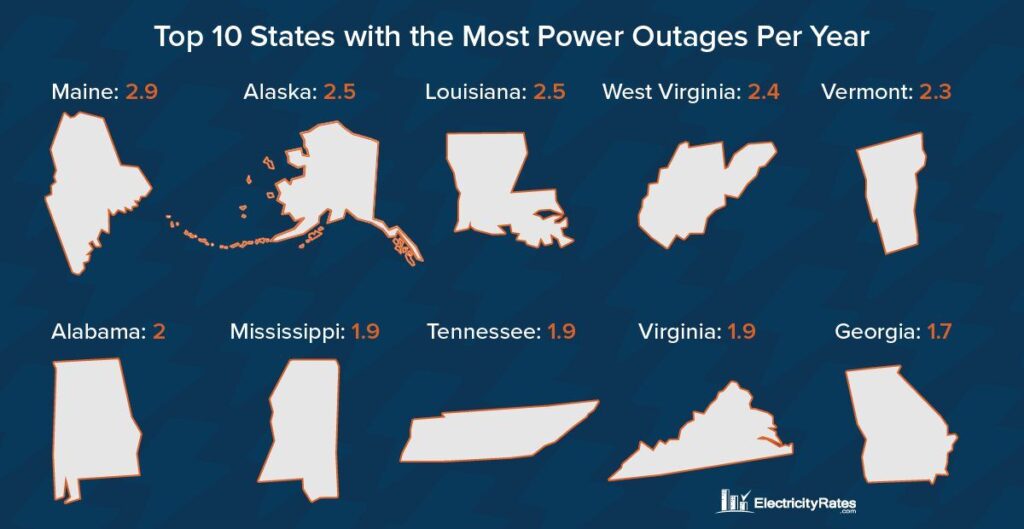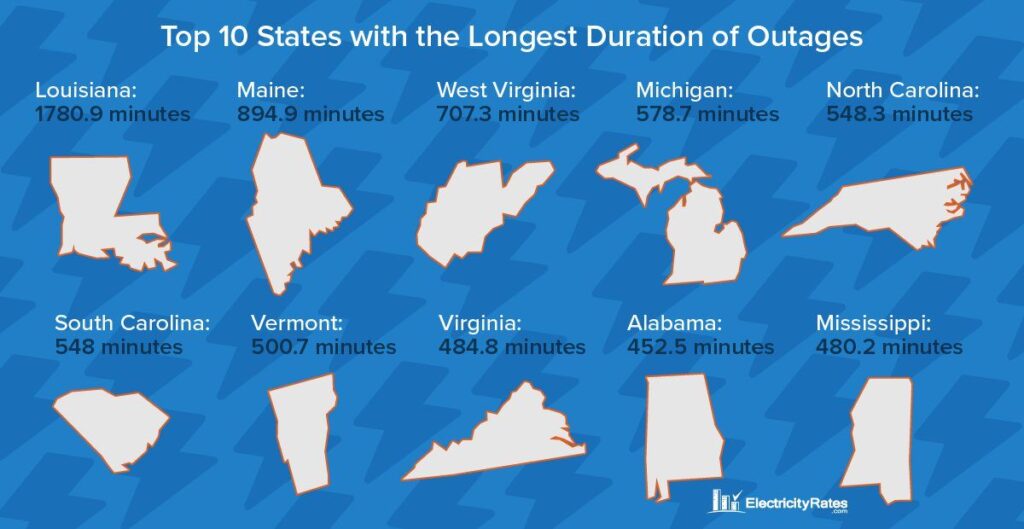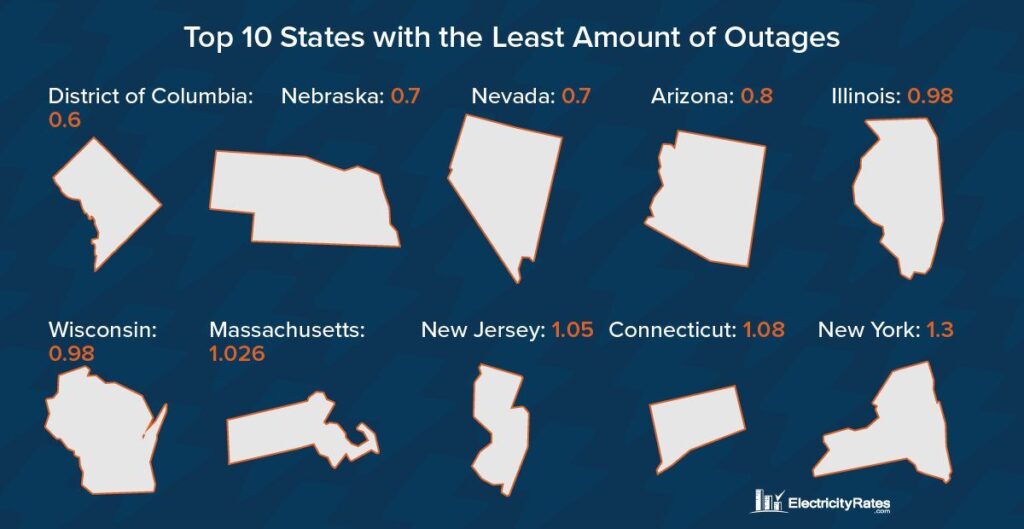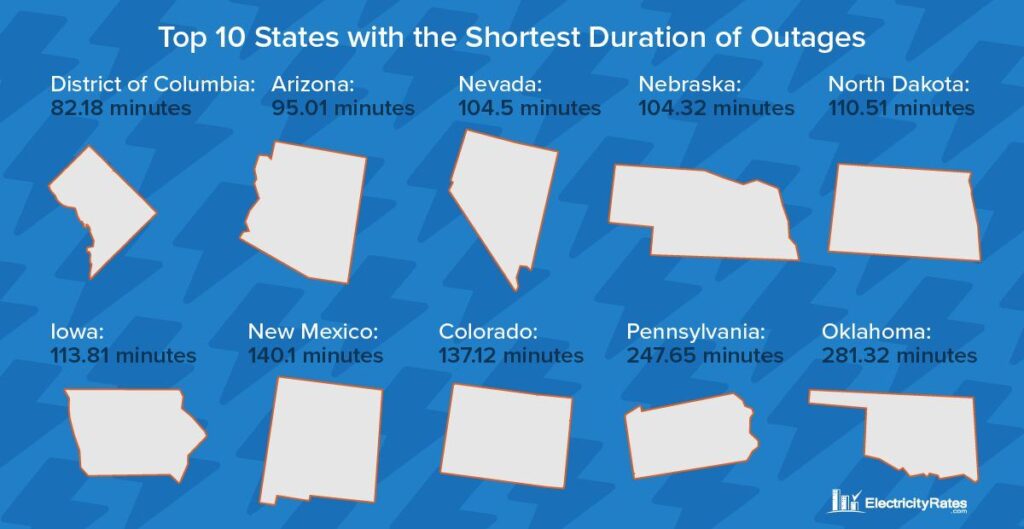The browser you are using is not supported. Please consider using a modern browser.

States with Record-setting Power Outages and the Impact to Remote Work
Key Takeaways
- States with More Outages: Power outages persist as a challenge, with some states facing more outages or longer interruptions. Among these states, Maine, Alaska and Louisiana stand out for their frequent outages, while Louisiana, Maine and West Virginia endure the longest durations.
- Impact on Remote Work: The interest in remote work continues to rise, yet challenges persist amidst power disruptions. States with reliable electricity infrastructure, like the District of Columbia and Nebraska, may offer better remote work conditions compared to those with persistent outages.
- Geographical Disparities in Remote Work Opportunities: The District of Columbia and Nebraska boast the lowest occurrence and shortest duration of power outages, enhancing remote work opportunities.
- Policy and Investment Implications: Targeted policies and investments are crucial to address outage challenges and support remote work growth. By studying the practices of top-performing states like the District of Columbia and Nebraska, other regions can improve their electricity distribution systems while minimizing disruptions.
Picture yourself fully engaged in remote work, diligently joining meetings, only to be suddenly cast into darkness due to a power outage. This isn’t just an occasional inconvenience but an increasingly frequent occurrence in today’s remote work environment.
With working from home now increasingly common, power outages can easily disrupt productivity. This report explores this issue, investigating how and where the workforce is contending with the obstacles presented by electrical outages.
As we navigate this uncertain terrain, crucial questions emerge:
- Which regions in the U.S. are bearing the brunt of these outages, and what are the implications for remote workers?
- How do electrical outages factor into the broader narrative of remote work, and what lessons can we glean for the future?
Through a comprehensive analysis, this report aims to shine a light on the intricate dynamics between extended power outages and the hurdles faced by remote workers while offering insights that speak to the experiences of both employers and employees alike.
It becomes evident that power outages could pose significant challenges to remote work productivity in particular regions where they are frequent and prolonged. High electricity demand, deteriorating infrastructure, and susceptibility to natural disasters exacerbate the severity of these outages. Considering these findings, we aimed to ask and explore answers to questions such as:
1. How can proactive infrastructure investments mitigate the impact of power outages on remote work productivity?
2. How might policy interventions bridge the geographical disparities in remote work opportunities across states?
3. Which states offer the best opportunities for remote workers in terms of both grid reliability and average salary?
There is hope for improvement through proactive infrastructure investments and targeted policies. Policy interventions can play a crucial role in bridging geographical imbalances in remote work opportunities, ensuring that all states have access to reliable electricity infrastructure. This, in turn, can make certain states more desirable for remote workers to reside in, especially when combined with high average salaries. Ultimately, by addressing these questions, we can pave the way for a future where remote work thrives amidst a stable and sustainable energy landscape.
Table of Contents

What Causes Outages?
Power outages pose a persistent challenge in the United States, affecting millions of individuals and businesses annually. Various factors may contribute to these disruptions, such as natural hazards and power grid reliability. A lot can be gleaned by analyzing data from the Energy Information Administration (EIA) which provides State Average Interruption Duration Index (SAIDI) and State Average Interruption Frequency Index (SAIFI) values.
Which States Have Had the Most and the Longest Outages?
Analyzing the State Average Interruption Duration Index (SAIDI) and State Average Interruption Frequency Index (SAIFI) values provides insight into the states most affected by electricity power outages. Based on a comprehensive six-year average of the most recent data from the Energy Information Administration (EIA), the following ranking identifies the top 10 states with the most outages.
To create this list, we averaged the latest values with major events and without major events for each state in recent years (up to 2022) and then ranked them based on the average number of outages a resident of this state would experience in a typical calendar year.

These states have experienced interruptions in electricity supply, indicating possible challenges in maintaining grid reliability and resilience. We also wanted to determine which U.S. states had the longest duration of outages. To identify these states, we averaged the latest number of outage minutes for each state in recent years (up to 2022). The states were then ranked based on the total number of minutes a state resident would have gone without power in an average calendar year.

This data compilation highlights which states have had significant disruptions to their power supply, emphasizing the necessity for proactive measures to mitigate future outages and ensure reliable electricity access for residents and businesses. The frequent interruptions and prolonged outages underscore the importance of addressing grid vulnerabilities to maintain consistent electricity access.
Contributing Factors
The most outages and the longest duration of power outages in the top 10 states can be attributed to a combination of factors, as evidenced by data from sources such as the Electric Disturbance Events annually via Energy.gov and the U.S. Energy Information Administration. Some of the factors that can contribute to outages include severe weather, natural disasters, transmission interruptions, or even vandalism. Another major contributor to outages is falling tree limbs. Many of the states with a high number of outages, including Maine, Alaska, and West Virginia, are highly forested.
Furthermore, the vulnerability of the power grid to natural disasters and extreme weather events may exacerbate outage frequency and duration. States highlighted in Power Grid Reliability reports from US News face significant risks from events such as hurricanes, wildfires and winter storms. These events can cause widespread damage to transmission and distribution lines, leading to prolonged outages. This may emphasize the need for robust resilience planning and investment in grid modernization initiatives.
Where Is the Least Amount of Power Outages with the Shortest Durations Recorded?
In the realm of electricity distribution, the frequency and duration of power outages play a critical role in assessing the reliability and resilience of the grid. We again examined the data presented in the State Average Interruption Duration Index (SAIDI) and State Average Interruption Frequency Index (SAIFI) to shed light on the regions within the United States that boast the lowest occurrence and shortest duration of power outages.
To create the list of states with the least amount of averages, we averaged the latest values with major events and without major events for each state in recent years (up to 2022), and then ranked them based on the average number of outages a resident of that region would experience in a typical calendar year.

To identify the regions with the shortest duration of outages, we averaged the latest number of outage minutes for each state in recent years (up to 2022). The regions were then ranked based on the total number of minutes a resident would have gone without power in an average calendar year.

By studying the practices of top-performing states, other regions can improve their electricity distribution systems, minimizing disruptions for communities and industries. These states have the most reliable electricity grids based on power outage frequency and duration.
Contributing Factors
But why are the above states so resilient? In part, this could be due to the fact that many of the states on our above lists have opted to invest heavily in grid modernization. In fact, according to the 2018 Grid Modernization Report (GMI-2018), many of the states that we identified as having very few outages or low amounts of electrical grid downtime including Illinois, Maryland, Arizona, and Washington D.C., among others are considered some of the top-ranked regions when it comes to grid modernization.
One notable exception to this is California, which ranks number one on the GMI-2018 but does not appear in either of our lists. This could be in part explained by the fact that the vast majority of this state, as demonstrated by FEMA’s National Risk Index, is at considerably higher risk of experiencing a natural disaster than the rest of the United States. Therefore, one could conclude that despite California’s high amount of investment into electrical grid resilience, this area still experiences frequent power outages simply because the state deals with a much greater amount of natural hazards than other regions in the United States.
But by and large, investing in the electrical grid has big benefits. States that invest in grid-resilience initiatives may demonstrate increased resilience against outages for the following reasons:
- Advanced Monitoring: Smart grid technology provides real-time data, helping operators detect and fix issues before they cause outages.
- Efficient Distribution: Upgrading circuits and deploying sensors improves power distribution, minimizing disruptions.
- Resilient Infrastructure: Upgrades reinforce the grid against extreme weather, reducing outage frequency and duration.
- Energy Storage: Storage projects offer backup power during outages, ensuring continuous supply.
- Climate Adaptation: Anticipating climate challenges and building resilience into infrastructure prepares grids for future impacts.
In addition, through the implementation of specific measures, states may effectively reduce the probability and duration of power supply disruptions. Stringent regulatory frameworks may also play a crucial role in ensuring reliable power delivery. This is evident in:
- States with effective regulatory bodies can hold utility companies accountable and incentivize investment in infrastructure upgrades.
- States with robust regulatory oversight may experience fewer and shorter power outages due to the proactive measures enforced by regulatory bodies.
- States with efficient regulatory frameworks not only ensure reliable power delivery but also set the stage for adaptable infrastructures.
This last point is particularly important if states want to be capable of supporting an increasingly high number of remote workers.
Remote Revolution: The Growing Work Trend
Remote work has become increasingly prevalent in today’s professional landscape, reshaping traditional notions of the workplace. We refer to a remote worker as an individual who performs their job duties outside of a traditional office environment, typically from home or another location away from a central workplace. They often rely on digital communication tools and technology to collaborate and contribute to their organization.
As technology continues to advance and attitudes toward work evolve, the benefits and challenges of remote work trends have come to the forefront.
According to the Pew Research Center, approximately 22 million employed adults in the U.S., constituting around 14% of all employed adults, work from home full-time. Additionally, over one-third of U.S. workers who can work remotely do so all the time, with 41% adopting a hybrid setup. By 2025, it’s projected that more than 1 in 5 Americans will work remotely.
Remote Work Trends
The remote work landscape is shifting. A significant majority of workers (98%) express a desire to work remotely at least some of the time, and 93% of employers plan to continue conducting job interviews remotely. Additionally, 16% of companies currently operate on a fully remote basis.
Benefits and Drawbacks of Remote Work
Remote work offers a multitude of benefits that contribute to a more fulfilling work experience. Some of the primary benefits include:
- The elimination of commutes saves time and reduces stress, as highlighted by 60% of WFH Research participants.
- 44% of respondents report significant cost savings on gas and lunch expenses, providing financial relief and increasing overall satisfaction with remote work arrangements.
- Additionally, the flexibility to choose work hours enables individuals to better balance their professional responsibilities with personal commitments, fostering a healthier work-life equilibrium, appreciated by 42% of participants.
However, the transition to remote work is not without its challenges. The constant stream of digital communication can lead to mental fatigue, underscoring the need for proper work boundaries and digital wellness strategies. Another challenge associated with remote work is the lack of face-to-face interaction, making it harder for remote workers to feel connected to their co-workers, as reported by surveys. Here are some intriguing findings:
- 69% of remote workers experience increased burnout from digital communication tools.
- Yet, 37% feel that remote work neither hurts nor helps with connection to co-workers, highlighting the need for effective communication and team-building strategies in a remote setting.
To facilitate remote work effectively, businesses need to invest in tools that will allow them to collaborate with their workers, no matter where they are. And many are doing exactly that.
Technology and Employer Policies
Businesses are investing in conferencing software to facilitate remote work effectively, with two-thirds of businesses making new investments in this area. Adequate technology infrastructure is crucial to supporting remote communication, collaboration, and productivity.
Employers will also need to adapt to the interest in remote work, as 58% of workers express willingness to seek new job opportunities if their current company doesn’t offer remote work options. Offering remote work flexibility can lead to increased productivity, as reported by one-third of hiring managers.
Job Opportunities Available for Remote Work
The demand for remote work is growing, with 65% of job seekers expressing a preference for full-time remote positions. This trend reflects a shift in work preferences towards flexible and remote-friendly arrangements.
Geographical Considerations
Remote work is significantly impacting the traditional work landscape, reshaping approaches to work and offering benefits like enhanced work-life balance and flexibility. However, remote work adoption rates differ across states, with over 21% of workers able to work remotely for five or more days a week between October 2023 and January 2024. Interestingly, the District of Columbia, which has the highest share of its population working from home according to the above report, also ranked as the number one area with the lowest amount and shortest duration of electrical outages.
Remote worker salaries also vary by location, with certain states like New York, New Hampshire and Vermont offering higher average salaries for remote positions.
As remote work gains momentum, both businesses and employees must adjust to this evolving landscape to fully harness its benefits and address challenges.
Lights On: State Electricity Infrastructure and Remote Work
To examine the correlation between state electricity infrastructure and its influence on remote work opportunities, we referenced the latest findings from Table 11.5, which offers SAIFI values at a state level and ZipRecruiter. Here are the 10 best states for remote workers in terms of average salary combined with the average number of power outages per year.
|
State
|
Average Remote Worker Salary
|
Average Annual Power Outages
|
|---|---|---|
| New York | $73,865 | 1.3 |
| New Hampshire | $68,733 | 1.5 |
| Vermont | $67,878 | 2.3 |
| Arizona | $64,511 | 0.8 |
| Wyoming | $64,452 | 1.5 |
| Hawaii | $63,725 | 1.8 |
| Tennessee | $63,581 | 1.9 |
| Massachusetts | $63,515 | 1 |
| Nevada | $62,253 | 0.7 |
| New Jersey | $62,981 | 1.05 |
1. New York: Leading the pack with a robust average remote work salary of $73,865, New York ensures a user-friendly environment with only 1.3 annual outages.
2. New Hampshire: With a competitive average remote work salary of $68,733, New Hampshire contributes to a seamless remote work experience with only 1.5 outages annually.
3. Vermont: Offering an attractive average remote work salary of $67,878, Vermont fosters productivity for remote professionals with roughly 2.3 annual power disruptions.
4. Arizona: With a solid average remote work salary of $64,511, Arizona demonstrates resilience by minimizing disruptions for remote workers with only 0.8 outages each year.
5. Wyoming: Sustaining an average remote work salary of $64,452, Wyoming enhances home workspaces with only 1.5 outages annually.
6. Hawaii: Hawaii offers a competitive average remote work salary of $63,725 along with 1.8 outages per year.
7. Tennessee: With its average remote work salary of $63,581, Tennessee experiences only 1.9 power disruptions each year.
8. Massachusetts: Boasting an average remote work salary of $63,515, Massachusetts reinforces its appeal with only 1 outage annually.
9. Nevada: Offering an average remote work salary of $63,253, Nevada ensures a consistent power supply for remote workers with just 0.7 disruptions per year.
10. New Jersey: With a remote work salary of $62,981, New Jersey’s effective grid management supports uninterrupted remote work activities with 1.05 power outages each year.
However, it is clear that some states may face challenges when it comes to offering opportunities for remote workers because of the low salaries for remote workers in the state and the longer duration of power outages. Here are the 10 worst states for remote workers with the lowest salaries coupled with their power outage durations.
|
State
|
Average Remote Worker Salary
|
Average Annual Power Outages
|
|---|---|---|
| Mississippi | $52,504 | 1.9 |
| Arkansas | $52,935 | 1.8 |
| Oklahoma | $52,356 | 1.6 |
| Georgia | $51,697 | 1.7 |
| Illinois | $51,664 | 0.98 |
| Michigan | $51,578 | 1.3 |
| Missouri | $51,027 | 1 |
| Texas | $50,608 | 1.8 |
| Louisiana | $48,777 | 2.5 |
| North Carolina | $45,344 | 1.6 |
1. Mississippi: With a remote work salary averaging $52,504, Mississippi has 1.9 annual power outages.
2. Arkansas: Arkansas maintains an average remote work salary of $52,395 and about 1.8 power disruptions annually.
3. Oklahoma: With a remote work salary averaging $52,356, Oklahoma goes through 1.6 power outages per year.
4. Georgia: While offering a remote work salary averaging $51,697, Georgia experiences, on average, 1.7 outages per year.
5. Illinois: The remote work salary for Illinois averages $51,664, along with 0.98 power disruptions each year.
6. Michigan: With an average remote work salary of $51,578, Michigan experiences 1.3 outages per year.
7. Missouri: Missouri has a remote work salary averaging $51,027 and 1 outage, on average, annually.
8. Texas: Texas offers a remote work salary averaging $50,608 and 1.8 power disruptions per year.
9. Louisiana: With a remote work salary averaging $48,777, Louisiana has roughly 2.5 outages each year.
10. North Carolina: With an average remote work salary of only $45,344, North Carolina goes through 1.6 power outages annually.
This analysis underscores a relationship between electricity infrastructure and remote work opportunities. Notably, the above states may experience difficulty when attracting remote workers, both due to their average low salaries and the fact that their higher average outage times could make it more difficult for remote workers to be productive.
Targeted investment and policy interventions could address some of the challenges faced by states with the most issues and foster a robust remote work landscape.
The convergence of remote work and electricity shortages poses a significant challenge for individuals and businesses in the evolving work culture landscape. Notably, states that experience frequent and prolonged power disruptions could affect the productivity of remote workers. As 2024 progresses, several key questions emerge:
1. Infrastructure Investments: How can proactive investments in infrastructure minimize the impact of power shortages on remote work efficiency? Modernizing infrastructure and improving grid reliability are crucial for addressing the root causes of outages.
2. Policy Interventions: How can policy interventions address geographical disparities in remote work opportunities among states? Targeted policies focusing on electricity infrastructure enhancement and remote work accessibility can help bridge the gap for workers regardless of location.
By addressing these questions, we pave the way for a future where remote work thrives in a stable energy environment, enhancing productivity, connectivity, and economic growth.
Key Implications
Analyzing the data on power outages and remote work opportunities reveals a few critical insights. In regions where power disruptions are frequent, businesses may face increased operational costs and productivity losses due to interrupted workflow, highlighting the need for strategic investments in infrastructure upgrades and modernization projects aimed at enhancing grid reliability and minimizing downtime.
Moving forward, targeted investments and policy interventions are essential to address these challenges and foster a robust remote work landscape nationwide. By leveraging these insights:
- Businesses and policymakers can make informed decisions to enhance grid reliability, support remote work growth, and ensure equitable access to opportunities across states.
- Frequent power outages could indicate disparities in access to remote work opportunities based on geographic location simply because remote workers would not have reliable electrical power to fulfill the basic requirements of holding these types of positions.
- Rural communities, often disproportionately affected by unreliable electricity infrastructure, may face additional challenges in participating fully in the remote work economy.
In addition to infrastructure improvements and policy interventions, fostering a culture of innovation and adaptation is crucial for navigating the challenges posed by power outages in the context of remote work. For instance:
- Promoting flexible work arrangements, such as hybrid or distributed work models, can mitigate the impact of power disruptions by allowing employees to work from alternative locations or adjust their schedules accordingly.
- By embracing innovation and flexibility, a more resilient remote work ecosystem can be created that will thrive even in the face of infrastructure challenges.
As we continue to adapt to the evolving dynamics of remote work and electricity infrastructure, proactive measures will be key to building a resilient and inclusive future for remote workers in 2024 and beyond.
Methodology
To generate the rankings and findings, we employed a rigorous methodology involving:
1. Data Collection: We gathered data from reputable sources, including the Energy Information Administration (EIA), Energy.gov, US News, FEMA National Risk Index, USA Today outage map tracker, and others, covering power outage frequency, duration, contributing factors, and remote work trends.
2. Selection of Metrics: Key metrics included the State Average Interruption Duration Index (SAIDI) and the State Average Interruption Frequency Index (SAIFI), providing insights into outage severity and frequency.
3. Calculation and Analysis: Utilizing SAIDI and SAIFI values, we analyzed total outages and cumulative outage durations for each state, identifying patterns of power disruption.
4. Ranking Methodology: States were ranked based on total outages and outage duration, facilitating clear comparisons.
5. Integration of Remote Work Data: We incorporated remote work trends, benefits, and challenges from reputable sources like Pew Research Center and WFH Research, providing a comprehensive view of power outages’ impact on remote work.
6. Interpretation and Synthesis: Findings were interpreted within the context of remote work dynamics and infrastructure challenges, offering actionable insights for stakeholders.
Overall, our methodology prioritized data integrity, transparency, and relevance to clarify the complex interplay between power infrastructure reliability and remote work opportunities. Through a systematic and evidence-based approach, we endeavor to empower readers with insights that inform decision-making and drive positive change in addressing the challenges posed by power outages in the context of remote work.